
A Dictionary of the Fuchsia™
Want to know what those mysterious terms mean and just who the people were behind those names? Then this is the place for you.
Want to know what those mysterious terms mean and just who the people were behind those names? Then this is the place for you.
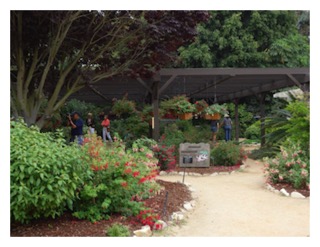
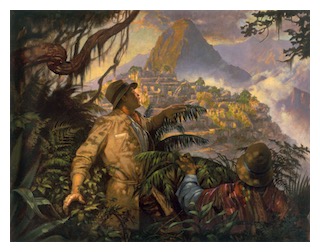
While superficially similar, Fuchsia boliviana should not be confused with Cantua buxifolia, a member of the phlox family and the so-called sacred flower of the Incas, Cantua is found growing in high valleys of the Yungas and is a national floral symbol in Peru and Bolivia. Known as Qantu, Qantus or Qantuta in Quechua, other common names include flor del Inca, magic-flower, magic-flower-of-the-Incas, magic-tree, and sacred-flower-of-the-Incas. Associated with perhaps the sun, purity and water, the Incas used it in rituals and ceremonies. Even long after the Inca period, the flower was found at funerals in the belief that the dead would quench their thirst on their journey into the afterlife by drinking its copious nectar. The cantuta continues to be a common decorative motif in traditional arts and crafts.
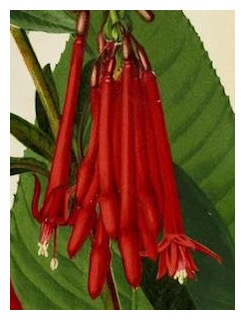
Chimpu-chimpu, on the other hand, seems to have had a more direct symbolic association with the Sapa Inca ruler himself. Indeed, Fuchsia boliviana remains one of the characteristic plants found along the roads and paths leading to Machu Picchu. The corolla around the sun’s disk was known as the Inti chimpu: The rays or fringe of the Sun God, Inti. Similarly a red fringe on the multicolored royal headband appears across the forehead of the Sapa Inca as part of his imperial regalia. His face is surrounded with the rays of the Sun, linking him directly to the most important and venerated god of the Inca pantheon. And serving as a constant to those that gaze at him just whom he represents.

Of recognized nobility, Garcilaso certainly had a coat of arms. On his shield, however, Garcilaso impaled his paternal arms with what would seem to be attributed arms representing his mother or her family. Since he was illegitimate, and not the main heir to his father and his family, it would have been normal to mark his paternal arms with some difference in this way. Interestingly, the main charge of these maternal arms resting on an azure blue field depicts a rainbow being swallowed at both ends by two crowned serpents. An impressive red tassel dangles from the middle of the rainbow between the two snakes. The chief is further charged with a golden sun and a silver moon in opposite corners.
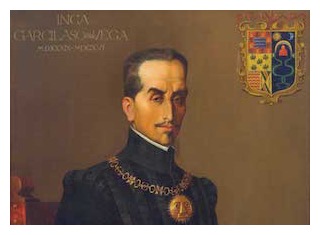
There are certainly mythological references in the composition but it seems the main charge is also a direct attempt to represent the regalia and headdress of the Sapa Inca. As an imperial symbol, it’s the equal of any double-headed eagle, purple lion or golden castle. A crown in the form of a multicolored headband of the rainbow, mythological snakes serving as ties, and, though reduced to a single large red tassel, marked with the rays of the Sun God himself. The regalia of a once powerful, if now conquered, empire. For Garcilaso, it’s an imperial vindication of his illegitimacy.
There are other contemporary arms attributed to the Inca rulers than those that appear on the sinister flank of Garcilaso’s shield. He might well have introduced those arms as a quartering along with his paternal quarters as an acceptable difference. Impalement is usually a matrimonial arrangement, uniting two matrimonial coats of husband and wife on a single shield. The red tassel is a direct allusion to his royal mother, Isabel Chimpu Ocllo. Could El Inca have been displaying his parent’s union as heraldically legitimate even if it wasn’t legally? As a young boy he certainly suffered his father’s neglect and then his outright rejection of his mother. It’s an interesting possibility.
(Illustrations: 1. Thomas Blackshear, Hiram Bingham's Discovery of Machu Picchu, Peru in 1911; 2. Detail. Fuchsia boliviana Carrière, Revue Horticole, serié 4, vol. 48, 1876; 3. Arms of ➤ El Inca Garcilaso de la Vega (1539-1616); 4. Portrait of El Inca Garciloso de la Vega with his arms.)
Index Kewensis (IK) – The central registry maintained by the Royal Botanical Gardens at Kew (see also) that seeks to include all botanical plant names on the generic level and below. The project was started about 1880 and uses the publication of Linnaeus' Systema Natura in 1753 as the starting point. Its first publication was in 1895. The Index Kewensis was never finalized but there is now an online database called the International Plant Names Index (IPNI) published in collaboration with the Harvard University Herbaria and the Australian National Herbarium that seeks to complete the registry.
Inflata – Inflated, swollen. See F. inflata (Schulze-Menz 1940) in ➤ Section Hemsleyella.
Inflorescence – A flower cluster.
Insignis – Remarkable, exceptional, extraordinary, distinguished or notable. See F. insignis (Helmsley 1876) in ➤ Section Hemsleyella.
Integrifolia – Entire leaves; undivided. F. integrifolia (Cambess. 1830) is a synonym of F. regia (Vand. ex Vell., Munz 1943) in ➤ Section Quelusia.
Intercalary – Pertaining to the meristem: situated between areas of permanent tissue. For example, intercalary growth from the base of a leaf in contrast to apical growth from the apex or tip of a plant's roots or shoots.
Intermedia – A hybrid or intermediate form. F. intermedia (Hemsley 1878) is a synonym of F. splendens (Zucc. 1832).
International Association for Cultivated Plant Taxonomy (IACPT) – The International Association for Cultivated Plant Taxonomy (IACPT) was founded in Wageningen, The Netherlands in 2007 during the Fifth International Symposium on the Taxonomy of Cultivated Plants. It’s stated objective was “to promote the field of taxonomy and nomenclature of cultivated plants and to encourage international relations among individuals and institutions interested in this field and related disciplines. Its members will include taxonomists who work on cultivated plants, international cultivar registration authorities, representatives of plant breeders rights authorities, plant breeders, crop scientists, agriculturists, foresters and horticulturists, plant physiologists and others”. Unfortunately ICNCP’s mission seems to have foundered: It only published one news letter No. 1 in 2008, it’s posted URL at iacpt.net has gone belly up, and it’s only ➤ on-line presence hasn’t seen an update since 2009.
International Association for Plant Taxonomy (IAPT) – The ➤ International Organization of Plant Taxonomy (IAPT) was founded in 1950 to carry out international projects of interest and concern to systematic botanists. It publishes the series Regnum Vegetabile, which includes the numerous editions of the International Code of Botanical Nomenclature (see also) the Index Nominum Genericorum, Taxonomic Literature (two editions), and the Index Herbariorum (parts 1 and 2). In addition, six issues of its journal Taxon are published each year, presently consisting of over eighteen hundred pages. IAPT is also responsible for the Inter-Congress Nomenclature Committees and the sessions on nomenclature at each International Botanical Congress. The most recent Congress was held in 2011 in Melbourne.
International Code for Botanical Nomenclature (ICBN) – See next entry below.
International Code of Nomenclature for algae, fungi, and plants (ICN) – The ICN is the set of rules and guidelines used when formally assigning botanical names. Formerly called the International Code for Botanical Nomenclature (ICBN), the name was changed by the 18th International Botanical Congress held in July 2011 to underscore the fact that algae and fungi are also covered. Note that the second part of the code name is not capitalized. It is also called the Melbourne Code as this is where the IBC meeting that modified the code took place. Previous revisions are similarly known by the location where the Congress meet. One of the most interesting novelties of 2011 revision saw the traditional requirement of a diagnosis, or validating description, using Latin changed to allow the use of either Latin or English.
➤ International Code.
International Plant Names Index – The ➤ International Plant Names Index, or IPNI, is a searchable on-line database containing published names and some basic associated bibliographical details on seed plants, ferns and lycophytes. The project is a collaboration between the Royal Botanic Gardens at Kew, the Harvard University Herbaria and the Australian National Herbarium and was initiated to eliminate the need for repeated reference to primary sources for basic bibliographic information about plant names. Since it wasn't within the IPNI's stated goals, there's no indication in the results that a name is currently recognized and they should be approached with an awareness that some might not now be invalid synonyms. Alternately, the Plant List (see also) does cover that lacuna well. Besides plant names, the IPNI includes standardized author abbreviations and botanical publications and new names and abbreviations are added constantly.
➤ IPNI's Fuchsias.
International Society for Horticulture Science – World organization based in Belgium responsible for keeping track of horticultural cultivar names to prevent duplication. In 1967, the ISHS appointed the American Fuchsia Society as the international registrar for the genus fuchsia in recognition of its leading role in recording American crosses since the launch of the AFS Registration Service in 1954.
Internode – The distance between sets of leaves along a stem. Some fuchsias, such as 'Cardinal,' have very long internodes and will make large scrambling bushes or even achieve almost vine-like growth suitable for trellises or arbors.
Internodal Rooting – Roots that develop from the internode rather than at the leaf axil or node. Fuchsias develop internodal roots more slowly than nodal ones so this fact should be considered when taking cuttings. See also Adventitous.
Intraspecific Name – Any scientific plant name below the rank of species. A subspecies, such as F. regia ssp. reitzii, is an infraspecific name. The only legitimate intraspecific botanical terms allowed by the ICN rules are subspecies, variety (or varieties), subvariety (or subvarietas), form (or forma), and subform (or subforma).
Involucrata – Having an involucre, literally a wrapping or case; having a bract around each flower; having the leaf edges rolled inwards. F. involucrata (Sw.1788) is a synonym of Schradera involucrata (Sw., K.Schum 1889), a member of the Rubiaceae, or Coffee Family. Another member of this family, Deppea splendens, is known as the Golden Fuchsia.
Isotype – In taxonomy, a specimen that is a duplicate of a holotype, the archetypical physical example of a plant or animal that was used when the species was formally described. See also ➤ Holotype.
Italics – Taxononic ranks, such as family, genus, species and subspecies are usually set in italics. Connectors such as subsp. (also ssp.) or var. are not. For example, Onagraceae or Fuchsia regia ssp. serrae.
Jack Lamb National Collection of Fuchsia Species – See ➤ National Collections (UK).
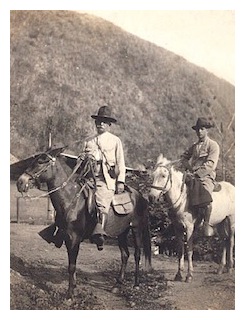
Jahnii – Named in honor of Alfredo Jahn Hartmann (1867-1940). F. jahnii is a now a synonym of F. gehrigeri. See ➤ Jahn; ➤ Gehriger; and F. gehrigeri in ➤ Section Fuchsia.
James Lye Fuchsias National Collection of Fuchsia Cultivars Introduced by James Lye – See ➤ National Collections (UK).
Jazmín de Papa, Jazmín del Papa – Very occasional common name for F. magellanica in Chile. Chilco, however, is the more usual and widespread common name used in that country.
Jimenez-Muñoz, Alfonso – Jiménez was a Costa Rican botanist and professor of Agronomy and Biology at the National University of Costa Rica, as well as the director of the National Museum of Costa Rica. It was Jiménez who first recognized and brought to the attention of other botanists that F. jimenezii was a species distinct from F. arborescens or F. paniculata, with which it was usually confused. The type on which the new species was published in his honor by Breedlove, Berry & Raven in 1983 was collected by Thomas C. Emmel in 1967 at Puntarenas in Costa Rica. F. jimenezii is the sole member of its section Jimenezia, also named in honor of Prof. Jiménez. See F. jimenezii in ➤ Section Jimenezia.
Jimenezii, Jimenezia – Named in honor of Alfonso Jiménez-Muñoz. See Jimenez; F. jimenezii in ➤ Section Jimenezia.
Johnston, Ivan Murray (1898-1960) – I.M. Johnston (1898–1960) was a American botanist whose areas of interest included the pteridophytes and spermatophytes. He studied at Pomona College in Claremont, California and at Harvard University. His plant collections are housed at the Rancho Santa Ana Botanic Garden in Claremont and in the Gray Herbarium at Harvard University. F. johnstonii (J.F.Macbride 19??), named in his honor, is an unresolved name.
Johnstonii – Named in honor of I.M. Johnston. F. johnstonii (J.F.Macbride 19??) is an unresolved name.
JStor Global Plants – A new on-line service from the renowned gatekeeper of academic publications. JStor Global Plants describes itself as a "community-contributed database where worldwide herbaria can share their plant type specimens, experts can update…", etc. The database already contains a wealth of botanical information but unfortunately any of the almost two million images are not scalable beyond a small thumbnail unless users are affiliated with a participating institution with an annual subscription.
➤ JStor Global Plants.
Juntasensis – From Junta in the Cochabamba Department of Bolivia. See F. juntasensis in ➤ Section Hemsleyella.
Kathleen Muncaster National Collection of Hardy Fuchsia – See ➤ National Collections (UK).
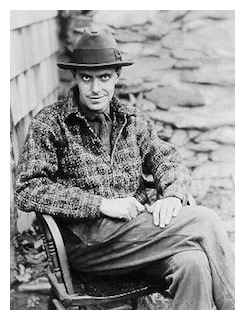
Killip collected widely on field expeditions, especially in Colombia and the tropical Americas, and over one hundred and fifty species came to be named in his honor. One of Killip's greatest achievements was the complete reorganization of the enormous collection of illustrations and plant specimens amassed by the Royal Botanical Expedition to New Grenada (see also) led by José Celestino Mutis (1732-1808) from 1783 until his death in 1808.
This historic and important botanical collection was all but forgotten and gathering dust for decades at the Royal Botanic Gardens in Madrid until Killip started a resurgence of interest in it in 1929. In 1953, after the interference of the Spanish Civil War and then World War II ended, the first of the botanical descriptions and illustrations of the expedition were jointly published by Spain and Colombia. Almost thirty volumes have been released since the start of the project but these still represent only a fifth of the total mass of material from the expedition.
Killip himself specialized in the Bomarea (Amaryllidaceae), as well as the Leguminosae and Passifloraceae.
F. killipii (Johnston 1925) was described in his honor but is now synonymous with F. venusta (Humbolt, Bonpland & Kunth 1823).
See F. venusta in ➤ Section Fuchsia; see also ➤ José Celestino Mutis; ➤ Royal Botanical Expedition to New Granada.
(Illustration: Ellsworth Killip at the ➤ Washington Biologists’ Field Club during the 1930s. US Geological Survey (USGS), United States Department of the Interior.)
Killipii – Named in honor Ellsworth P. Killip (1890-1968). F. killipii (Johnston 1925) is now synonymous with F. venusta (Humbolt, Bonpland & Kunth 1823). See ➤ Killip; see also F. venusta in ➤ Section Fuchsia.
Kirschleger, Frédéric R. (1804-1869) – Kirschleger was a French physician and botanist born in the small Alsatian town of Münster, located on the border with Germany. Following studies in Strasbourg, he worked as an intern of pharmacy, first in Ribeauvillé then at the Hôpital Civil in Strasbourg. He later studied medicine in Paris from 1827-28, where he received his doctorate with a thesis on the mineral waters of Vosges, and returned to Münster as a doctor in 1829. In 1834 he was appointed a professor of botany at the school of pharmacy in Strasbourg. In 1845 he founded the Société d'Horticulture du Bas-Rhin, and in 1862 established the Société philomathique vogésorhénane (Philomatic Society of the Vosgés-Rhine). Among his notable achievements is the Flore d’Alsace et des contrées limitrophes, a highly regarded work on the flora of Alsace and neighboring regions, published in three volumes from 1852 to 1862.
Kierschlegeria – Named in honor of Frédéric R. Kirschleger (1804-1869). See ➤ Section Kierschlegeria.

F. kirkii was named in his honor but is now a synonym of F. procumbens.
(Illustration: Portrait of Thomas Kirk, before 1898.)
Kirkii – Named in honor of Thomas Kirk. F. kirkii (Hook. f. 1871) and F. kirkii (Hook.f. ex Kirk 1868) are synonyms of F. procumbens (R.Cunningham 1839) in ➤ Section Procumbentes. F. procumbens is subdioesceous and the male-flowered form was confused and described as a separate species.
Kohutuhutu – Alternative Maori name for ➤ Kotukutuku.
Konini – Maori name for the berries of the Kotukutuku, or native Tree Fuchsia (F. excorticata) of New Zealand. The word is sometimes incorrectly applied to the whole tree. See also Berries.
Koninidites aspis – See Pollen Fossils.
Kotukutuku – Maori name for F. excoticata, the native Tree Fuchsia of New Zealand (see ➤ Section Skinnera). The Maori have an old saying, "I whea koe I te tahuritanga o te rau o te kotukutuku?", or "Where were you when the leaves of the Fuchsia tree began to grow in the spring?" It’s a reproach against those who show up at harvest time but were nowhere to be found when work needed to be done at planting time. See also Konini, Tree Fuchsia.
Küpe çiçeği – Turkish name for the fuchsia. It translates as Earring Flower. Also sometimes rendered as Küpeçiçeği.





